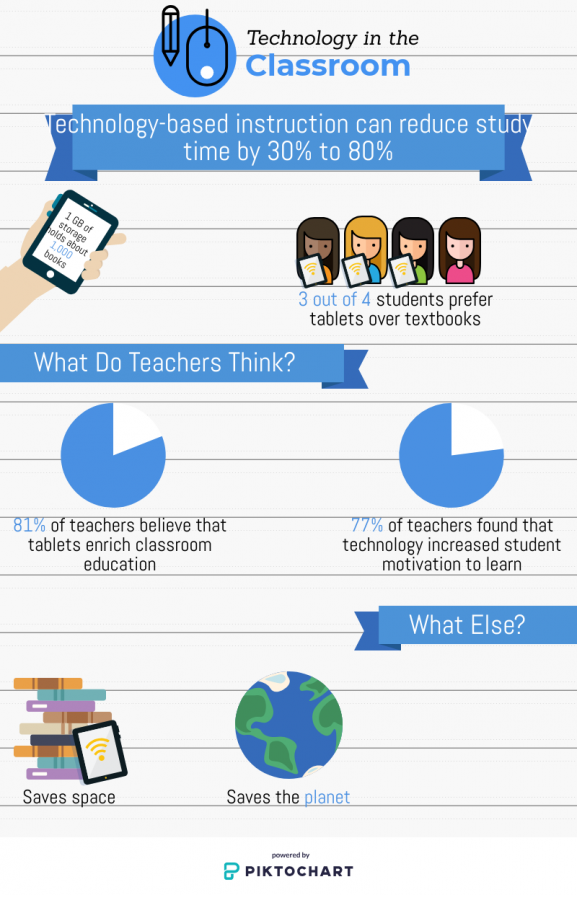Print books vs e-readers
May 30, 2018
Books, bytes, and beyond
Call me an old-fashioned book nerd, but I don’t have a Kindle. Or a Nook.
But I do have a shelf full of books at home. I enjoy walking to the library. I enjoy the thrill of opening a new book and the satisfaction of closing it when I’m done. I used to read to my grandma, and through books I’ve bonded with friends and made new ones. I sometimes read at restaurants. Am I the only person that does this?
Yes? No? Maybe so?
But today, in the age where technology seems like it’s taking over the world, I’m seeing more e-readers pop up. It’s not a bad thing, but I’d like to see more tangible books out there. Now, some argue that e-books save the environment, and they do, to a certain degree. Even though paper takes up the most space in landfills, e-waste or electronic waste is much more harmful to the environment. Only 2% of municipal solid waste is e-waste, containing toxic metals, like lead and mercury. In the United States, approximately only 20% of e-waste is recycled, while 70% of that recycled e-waste is shipped to China. There, people separate valuable metals from everything else, using acids and fire without proper protection. These people, including children, inhale fumes. Children are more susceptible to neurological, digestive, and immune disorders caused by exposure to toxic metals because they need more air, food, and water than adults do.
Consider the carbon footprint of paper books and e-books. A product’s carbon footprint is how much carbon dioxide is released into the atmosphere during its lifetime. The carbon footprint of a traditional book is 7.5kg, while for an e-reader it’s 168kg in total. iPads have a carbon footprint of 130kg CO2eq. Electronics use energy and require more fossil fuels the more they are used, causing the need for more fossil fuels to be mined. This negatively affects the environment. Even though manufacturing fewer paper books saves trees and reduces some CO2 emissions, the industry manufacturing e-readers emits CO2 into the atmosphere. Carbon dioxide, a greenhouse gas, stays in the atmosphere and traps heat, warming the earth, contributing to global warming and climate change.
E-books don’t just pose a threat to the environment. They also interfere with human health and child development. Neurotherapist Dr. Mari K. Swingle deals with society, technology, and its health effects. She is the author of i-Minds: How Cell Phones, Computers, Gaming and Social Media are Changing Our Brains, Our Behavior, and the Evolution of Our Species. It explains how people are constantly using technology and how it impacts our society. Dr. Swingle has several articles on the subject of humans and technology. She writes that using technology and electronics for long periods of time can cause disorders such as anxiety, depression, and ADHD. It can change how humans communicate with each other. Children are susceptible to development issues when glued to a screen for so long.
On the bus for this year’s choir trip, my roommate was constantly on her e-reader. She had so many books stored, some she even got for free. Students are constantly on their phones or tablets, reading books and playing games. Technology is also being used more frequently in schools, as we implemented the one-to-one laptop program this year.
Three studies were conducted using college students, and even though students read faster and preferred to read on screens, they understood the information better when reading print books. Swingle mentions that excessive use of technology can cause the brain to rewire itself during childhood development and cause behavioral issues. People are used to focusing on a screen, so there is a lack of connection and communication.
Excessive time on electronics can cause dryness of the eyes and blurred vision. Electronic screens are backlit, giving off a blue light called high-energy visible (HEV) light. Increased exposure to HEV light restrains melatonin, a sleep hormone, messing up sleep schedules. In a survey of 9,700 of American adults, 43% said they spend a significant amount of time on their e-reader.
If you’re concerned about the effects of books and e-readers, recycle paper books for your library’s used book sale. You can also borrow audiobooks from the library. Try limiting the amount of time you spend on your e-reader. Your eyes and brain will thank you. So will Mother Earth.
It’s time for a digital evolution
eBooks and similar devices have risen in popularity in the last decade. However, many Americans still prefer the printed word over eBooks available on Kindles and other devices. Perhaps, for many of us, the aesthetic and simplicity is why paper books are still preferred. Nevertheless, the popularity of eBooks is a powerful trend that cannot be denied, and a stronger transition to using eBooks inside and outside of the classroom will have benefits for everyone involved.
Each year, classrooms across the nation utilize hundreds of books to educate their students. However, these books need to be replaced when possibly lost or damaged. The books would also have to be replaced over time anyway since they would become outdated. Schools across the country could easily go through hundreds of books each year.
According to the Omega Institute for Holistic Studies, the energy, water, and raw materials needed to make a single e-reader is equal to about 40-50 books. In terms of the effect on the climate, the emissions created by a single e-reader are equal to roughly 100 books. Schools of any size can easily exceed that amount of books each academic year, meaning that using digital in the classroom would have no more of an effect on the environment than using printed books would.
Saving the environment is a great reason to transition to digital, but it can also help save space. Schools everywhere need clunky bookshelves or carts to transport books, and sometimes whole storage rooms just to store sizable textbooks for students. But, tablets usually have 64 Gigabytes of storage. Well, what exactly does 64GB mean in terms of storage? Considering that on average, just 1GB can hold up to 1,000 books, tablets have more than enough capacity for all of a student’s needs.
But not only are tablets beneficial for the environment and for storage purposes, they’re beneficial for the students using them as well. When you can store thousands of books and assignments on one tablet, there’s more room to store other supplies and less money spent on bookshelves and carts to transport them from classroom to classroom.
And diversifying the classroom with digital learning is a change students want to see. On average, 3 out of 4 students prefer tablets over textbooks. Also, technology based instruction/learning can reduce the time needed for students to learn material by 30%-80%, according to the U.S. Department of Education and several studies by the National Training and Simulation Association.
This is a change teachers want to see in the classroom as well. According to a survey done by PBS, 81% of K-12 teachers believe that tablets enrich classroom education, and 77% of teachers found that technology increases student motivation to learn. With results like these, technology being introduced into the classroom will be a more interesting and engaging experience for students and teachers alike.

